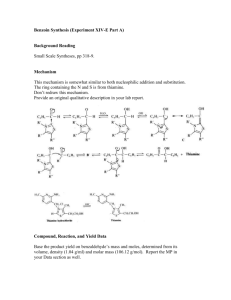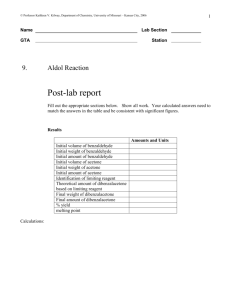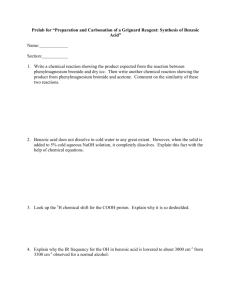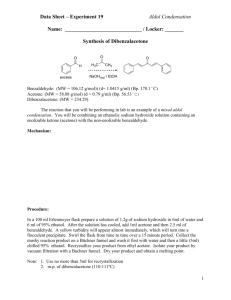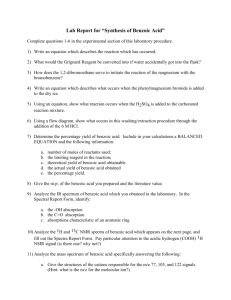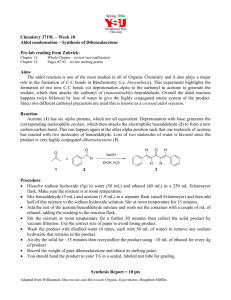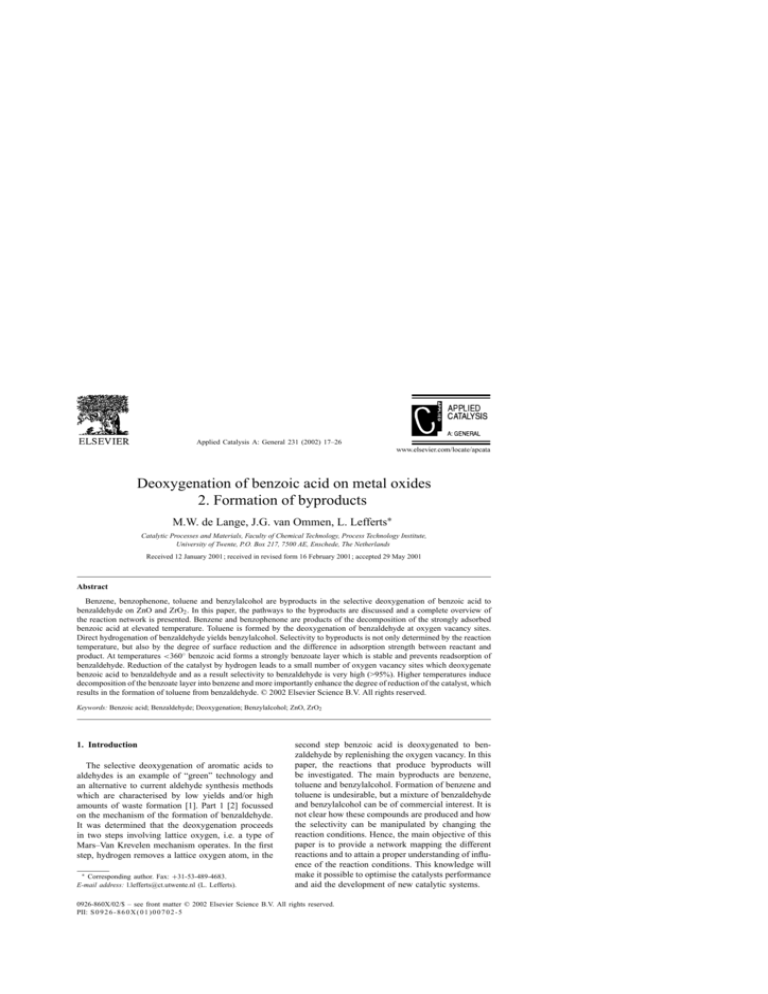
Applied Catalysis A: General 231 (2002) 17–26
Deoxygenation of benzoic acid on metal oxides
2. Formation of byproducts
M.W. de Lange, J.G. van Ommen, L. Lefferts∗
Catalytic Processes and Materials, Faculty of Chemical Technology, Process Technology Institute,
University of Twente, P.O. Box 217, 7500 AE, Enschede, The Netherlands
Received 12 January 2001; received in revised form 16 February 2001; accepted 29 May 2001
Abstract
Benzene, benzophenone, toluene and benzylalcohol are byproducts in the selective deoxygenation of benzoic acid to
benzaldehyde on ZnO and ZrO2 . In this paper, the pathways to the byproducts are discussed and a complete overview of
the reaction network is presented. Benzene and benzophenone are products of the decomposition of the strongly adsorbed
benzoic acid at elevated temperature. Toluene is formed by the deoxygenation of benzaldehyde at oxygen vacancy sites.
Direct hydrogenation of benzaldehyde yields benzylalcohol. Selectivity to byproducts is not only determined by the reaction
temperature, but also by the degree of surface reduction and the difference in adsorption strength between reactant and
product. At temperatures <360◦ benzoic acid forms a strongly benzoate layer which is stable and prevents readsorption of
benzaldehyde. Reduction of the catalyst by hydrogen leads to a small number of oxygen vacancy sites which deoxygenate
benzoic acid to benzaldehyde and as a result selectivity to benzaldehyde is very high (>95%). Higher temperatures induce
decomposition of the benzoate layer into benzene and more importantly enhance the degree of reduction of the catalyst, which
results in the formation of toluene from benzaldehyde. © 2002 Elsevier Science B.V. All rights reserved.
Keywords: Benzoic acid; Benzaldehyde; Deoxygenation; Benzylalcohol; ZnO, ZrO2
1. Introduction
The selective deoxygenation of aromatic acids to
aldehydes is an example of “green” technology and
an alternative to current aldehyde synthesis methods
which are characterised by low yields and/or high
amounts of waste formation [1]. Part 1 [2] focussed
on the mechanism of the formation of benzaldehyde.
It was determined that the deoxygenation proceeds
in two steps involving lattice oxygen, i.e. a type of
Mars–Van Krevelen mechanism operates. In the first
step, hydrogen removes a lattice oxygen atom, in the
∗ Corresponding author. Fax: +31-53-489-4683.
E-mail address: l.lefferts@ct.utwente.nl (L. Lefferts).
second step benzoic acid is deoxygenated to benzaldehyde by replenishing the oxygen vacancy. In this
paper, the reactions that produce byproducts will
be investigated. The main byproducts are benzene,
toluene and benzylalcohol. Formation of benzene and
toluene is undesirable, but a mixture of benzaldehyde
and benzylalcohol can be of commercial interest. It is
not clear how these compounds are produced and how
the selectivity can be manipulated by changing the
reaction conditions. Hence, the main objective of this
paper is to provide a network mapping the different
reactions and to attain a proper understanding of influence of the reaction conditions. This knowledge will
make it possible to optimise the catalysts performance
and aid the development of new catalytic systems.
0926-860X/02/$ – see front matter © 2002 Elsevier Science B.V. All rights reserved.
PII: S 0 9 2 6 - 8 6 0 X ( 0 1 ) 0 0 7 0 2 - 5
18
M.W. de Lange et al. / Applied Catalysis A: General 231 (2002) 17–26
The same catalysts as in the previous publication
[2], i.e. ZnO and ZrO2 will be studied. At low conversions the byproduct formation is very small so reaction
conditions have to be set at which specifically the selective reaction to benzaldehyde is unfavourable. This
is done by operating at different temperatures, partial
pressures of the reactants, working at different flow
rates, by using byproducts as reactants and by manipulating the concentration of active sites, i.e. oxygen
vacancies.
2. Experimental
The experiments were carried out with a continuous
flow apparatus operating at atmospheric pressure. A
hydrogen or nitrogen flow passed through a saturator
containing the reactant and this feed was fed to the
reactor. The product stream leaving the reactor was
dissolved in ethanol and collected in two condensers.
The condensate was injected into a Varian 3700
gas chromatograph equipped with a 25 m wide-bore
CP-Sil 13 column (Chrompack NL) for product analysis. The set-up is described in more detail in Part 1
[1].
In most experiments, samples were acquired
every 25 min and the reaction conditions were only
changed when several samples taken under the same
conditions produced identical results. Exceptions
were made for experiments where there was a transient effect occurring. In those instances, it should
be emphasised that the results are the average of
what was collected in the condenser over a 25 min
period.
The partial pressure of benzoic acid was varied by
changing the temperature of the saturator containing
the reactant. The partial pressure of hydrogen was
altered by diluting hydrogen with nitrogen. Contact
times were varied by changing the flow rates of the
carrier gas.
The definitions of the carbon atom-based conversion
per unit weight catalyst, yield and selectivity are the
same as in Part 1.
The same batch of ZnO and ZrO2 was used as Part 1
and details of the preparation procedure can be found
there. The BET surface areas of the catalysts before
reaction were 50 and 96 m2 /g for ZnO and ZrO2 ,
respectively.
3. Results
The catalytic behaviour of ZnO and ZrO2 in the
deoxygenation of benzoic acid as a function of temperature was reported in our previous paper [2]. In
short, at 360 ◦ C the selectivity to benzaldehyde is very
high (>95%) on both catalysts with some benzylalcohol formed on ZnO which is the more active of the
two catalysts. At higher temperatures (>400 ◦ C) conversion of benzoic acid is complete and considerable
amounts of toluene and benzene are formed.
The effect of contact time on selectivity is shown
in Fig. 1. At short contact times benzaldehyde is
highly favoured. It appears that byproducts emerge
only when all of the benzoic acid has been completely converted into benzaldehyde. Toluene is the
main byproduct whereas a small amount of benzene is
formed at very long contact times. Benzylalcohol formation is very small at this temperature, regardless of
contact time. The pattern of byproduct formation appears the same for ZnO as for the ZrO2 catalysts, but
the ZnO catalyst is much more active in the formation
of both benzaldehyde and byproducts. This experiment suggests that consecutive reactions involving
benzaldehyde play an important role in the formation
of byproducts. Therefore, experiments were undertaken with benzaldehyde as a feedstock replacing
benzoic acid. The results are shown in Fig. 2.
At low temperature benzaldehyde is hydrogenated
to benzylalcohol. At elevated temperature toluene
is the main product. A small amount of benzene is
also detected at 430 ◦ C. The yield of these two products is higher with benzaldehyde as the reactant than
with benzoic acid. Just as in the previous experiment
(Fig. 1) the behaviour of the ZrO2 catalyst resembles
that of the ZnO catalyst but the ZnO catalyst is more
active in the formation of all three products.
Additional information regarding the reaction network was gathered by reacting benzylalcohol over the
catalysts (Fig. 3). Benzylalcohol is rapidly converted
into benzaldehyde, i.e. a dehydrogenation takes place
despite the fact that the catalyst is operating in a hydrogen atmosphere. At longer contact times toluene is
formed, but both figures indicate that this is the result
of the deoxygenation of benzaldehyde and not of the
hydrogenolysis of the C–OH bond in benzylalcohol.
Fig. 4 shows the effect of an increase of the partial
pressure of benzoic acid on the selectivity. An increase
M.W. de Lange et al. / Applied Catalysis A: General 231 (2002) 17–26
19
Fig. 1. Deoxygenation of benzoic acid at 400 ◦ C on ZnO (left) and ZrO2 (right) as a function of contact time. Symbols: (䉬) benzoic
acid conversion; (䊏) benzaldehyde yield; (䊉) benzylalcohol yield; () toluene yield; (䊊) benzene yield. Reaction conditions: catalyst,
500 mg; hydrogen flow rate, 10–60 ml/min; benzoic acid partial pressure, 13 mbar.
Fig. 2. Hydrogenation of benzaldehyde on ZnO (left) and ZrO2 (right) as a function of temperature. Symbols: (䉬) benzaldehyde conversion;
(䊉) benzylalcohol yield; () toluene yield; (䊊) benzene yield. Reaction conditions: hydrogen flow rate, 40 ml/min; benzaldehyde partial
pressure, 13 mbar; benzaldehyde W/F, 0.39 kg mol−1 h.
Fig. 3. Reactions of benzylalcohol in hydrogen at 400 ◦ C on ZnO (left) and ZrO2 (right) as a function of contact time. Symbols: (䉬)
benzylalcohol conversion; (䊏) benzaldehyde yield; () toluene yield; (䊊) benzene yield. Reaction conditions: catalyst, 500 mg; hydrogen
flow rate, 10–60 ml/min; benzylalcohol partial pressure, 13 mbar.
20
M.W. de Lange et al. / Applied Catalysis A: General 231 (2002) 17–26
Fig. 4. Deoxygenation of benzoic acid at 400 ◦ C on ZnO (left) and ZrO2 (right) as a function of benzoic acid partial pressure. Symbols:
(䉬) benzoic acid conversion; (䊏) benzaldehyde yield; (䊉) benzylalcohol yield; () toluene yield; (䊊) benzene yield. Reaction conditions:
catalyst, 500 mg; hydrogen flow rate, 40 ml/min.
in the partial pressure leads to a substantial reduction
in the selectivity towards toluene on both catalysts.
On ZnO the yield of toluene decreases from 79 to 8%
when the benzoic acid partial pressure is raised from
13 to 30 mbar. The effect on the formation of benzene and benzylalcohol is small, indicating a different
origin.
In another experiment, the partial pressure of hydrogen was varied. The results are depicted in Fig. 5
for the ZnO catalyst and Fig. 6 for the ZrO2 catalyst.
Selectivity to toluene is >90% on ZnO at 430 ◦ C if
hydrogen is the only carrier gas. Reducing the hydrogen partial pressure (by diluting with nitrogen)
lowers the selectivity to toluene significantly. If 75%
of the hydrogen has been replaced by nitrogen the
selectivity to toluene has dropped to 15% and meanwhile the selectivity to benzaldehyde has increased
to 81%. In total absence of hydrogen in the feed,
mainly benzene is produced with some minor benzophenone formation. Upon re-introducing hydrogen
to the feed immediately the formation of these two
byproducts drops and benzaldehyde returns as the
main product. At high hydrogen partial pressure the
high selectivity to toluene reappears. On ZrO2 to
some extent the same behaviour can be observed.
Lowering the hydrogen partial pressure results in
a decrease in toluene selectivity in favour of benzaldehyde. However, in the absence of hydrogen
Fig. 5. Deoxygenation of benzoic acid at 430 ◦ C on ZnO as a function of hydrogen partial pressure. Symbols: (䉬) benzoic acid conversion;
(䊏) benzaldehyde yield; (䊉) benzylalcohol yield; () toluene yield; (䊊) benzene yield. Reaction conditions: carrier gas (H2 + N2 ) flow
rate, 40 ml/min; benzoic acid partial pressure, 13 mbar; benzoic acid W/F, 0.39 kg mol−1 h.
M.W. de Lange et al. / Applied Catalysis A: General 231 (2002) 17–26
21
Table 1
Effect of the addition of carbon dioxide on product yield on ZnO
at 360 ◦ Ca
Carrier gas
composition
Conversion
(%)
Benzaldehyde
yield (%)
H2 :N2 4/1
H2 :CO2 4/1
100
99
99
98
a Reaction conditions: carrier gas flow rate, 40 ml/min; benzoic
acid partial pressure, 13 mbar; benzoic acid W/F, 0.39 kg mol−1 h.
Table 2
Effect of the addition of carbon dioxide on product yield on ZnO
at 420 ◦ Ca
Fig. 6. Deoxygenation of benzoic acid at 430 ◦ C on ZrO2 as a
function of hydrogen partial pressure. Symbols: (䉬) benzoic acid
conversion; (䊏) benzaldehyde yield; (䊉) benzylalcohol yield; ()
toluene yield; (䊊) benzene yield. Reaction conditions: catalyst,
500 mg; carrier gas (H2 + N2 ) flow rate, 40 ml/min; benzoic acid
partial pressure, 13 mbar; benzoic acid W/F, 0.39 kg mol−1 h.
benzene formation is only very small in contrast to
ZnO.
In Part 1, carbon dioxide was used as a probe
molecule with specific affinity for oxygen vacancies.
As such it could, in principle, also be added to the
feed with the objective to decrease the amount of
oxygen vacancies as active sites under steady state
conditions. Carbon dioxide was introduced into the
feed at 360 ◦ C at which temperature benzaldehyde
is predominantly formed and at 430 ◦ C when selectivity to toluene is high. In Table 1, the results of
the former experiment are presented. The effect of
adding carbon dioxide to the feed is hardly noticeable at 360 ◦ C. At 420 ◦ C, on the other hand, the
effect is quite dramatic (Table 2). Toluene formation
is largely suppressed by the presence of carbon dioxide, while the benzaldehyde yield increases almost
three-fold.
Hydrogenation of benzaldehyde to benzylalcohol
might proceed via a Cannizzarro-type mechanism. The
Carrier gas
composition
Conversion
(%)
Toluene
yield (%)
Benzaldehyde
yield (%)
H2 :N2 4/1
H2 :CO2 4/1
100
100
64
22
29
75
a Reaction conditions: carrier gas flow rate, 40 ml/min; benzoic
acid partial pressure, 13 mbar; benzoic acid W/F, 0.39 kg mol−1 h.
formal equation for this reaction is:
2C6 H5 CHO + OH− → C6 H5 CH2 OH + C6 H5 COO−
(1)
This reaction takes place when the OH groups are the
only source of O as the oxidising agent. To check
for this reaction the catalyst was hydrated by passing
water vapour over the catalyst followed by a feed of
benzaldehyde in nitrogen. A small amount (2%) of
benzylalcohol was formed on the ZrO2 catalyst which
decayed to zero over time, but not on the ZnO catalyst.
The formation of benzylalcohol was higher (9%) when
a mixture of benzaldehyde and hydrogen was led over
non-hydrated ZrO2 .
As a test reaction, the hydrogenation of acetophenone was also studied. The analogue of Eq. (1) for
this reactant is
2C6 H5 C(CH3 )O + OH− → C6 H5 C(CH3 )2 OH
+C6 H5 COO−
(2)
Table 3
Acetophenone hydrogenation on ZnO and ZrO2 at 360 ◦ Ca
Catalyst
ZnO
ZrO2
a
Conversion (%)
90
78
Yield (%)
Benzene
Ethylbenzene/styrene
Benzaldehyde
Heavy products
3
9
77
43
4
7
5
17
Reaction conditions: hydrogen flow rate, 40 ml/min; acetophenone partial pressure, 13 mbar; acetophenone W/F, 0.39 kg mol−1 h.
22
M.W. de Lange et al. / Applied Catalysis A: General 231 (2002) 17–26
Thus, if 2-phenyl-2-propanol is formed, this would
provide evidence of a concerted Cannizzarro-type
mechanism. However, this was not observed. Instead
the main product of this reaction was either ethylbenzene or styrene (see Table 3). These two compounds
gave practically identical retention times in the gas
chromatogram of the GC used and so, unfortunately,
no distinction could be made.
4. Discussion
There are two main pathways in the selective deoxygenation of benzoic acid, as discussed in Part 1:
1. A selective pathway in which benzaldehyde is
formed. This reaction proceeds via a reverse type
of Mars–Van Krevelen mechanism. Hydrogen reduces the catalyst so that oxygen vacancies are
produced which deoxygenate benzoic acid to
benzaldehyde.
2. A non-selective pathway in which benzene and
benzophenone are formed preferentially. These
products are formed via the slow decomposition
of strongly bound benzoates.
First, the reactions that produce toluene, benzylalcohol, benzene and benzophenone will be reviewed.
At the end of the discussion an overall picture of the
reaction network is presented.
4.1. Toluene formation
There are three potential reaction pathways for the
formation of toluene:
1. direct reduction of benzoic acid
C6 H5 COOH + 3H2 → C6 H5 CH3 + 2H2 O
2. hydrogenation or hydrogenolysis of benzylalcohol
C6 H5 CH2 OH + H2 → C6 H5 CH3 + H2 O
3. hydrogenation (deoxygenation) of benzaldehyde
C6 H5 CHO + 2H2 → C6 H5 CH3 + H2 O
Reaction (1) can be excluded on ZnO and ZrO2 . At
short contact times toluene is not seen among the primary products (Fig. 1). Furthermore, toluene formation was also absent in the temperature programmed
reactions shown in Part 1. Reaction (2) seems plausible considering the reduction sequence shown in
Scheme 1 suggested by Yokoyama et al. [3].
However, when benzylalcohol is led over the catalyst, benzaldehyde is formed initially (Fig. 3). Clearly
toluene is a secondary product formed from benzaldehyde. Furthermore, at long contact time benzaldehyde
selectivity drops and toluene selectivity rises (Fig. 1).
It was shown in Part 1 that oxygen vacancies are
present on the catalyst during benzoic acid deoxygenation so this must also be the case during the experiments with the benzaldehyde feed with identical
hydrogen pressure. If these reactive defect sites are
able to deoxygenate benzoic acid it is fair to expect
that they can deoxygenate benzaldehyde to toluene as
well. Ample evidence for this deduction, that reaction
(3) proceeds via a reverse type of Mars–Van Krevelen
mechanism and is the main source of toluene, can
be gathered from the experiments. First, the concentration of oxygen vacancies depends on the ratio
of oxidant and reductant. If this ratio is increased
(by either increasing the partial pressure of benzoic
acid or lowering the partial pressure of hydrogen)
the concentration of oxygen vacancies will be small
which means that few of those sites are available for
benzaldehyde re-adsorption and deoxygenation. Consequently, the selectivity to toluene will drop and this
is indeed observed (Figs. 4 and 5). Moreover, another
method of decreasing the concentration of oxygen vacancies is by the adding another oxygen donor to the
feed, in our case carbon dioxide [4–8]. This results in
a drop in toluene selectivity as well. It is possible that
the formation of toluene proceeds without desorption
and re-adsorption of benzaldehyde. In that case, the
adsorbed benzoic acid loses both its oxygen atoms at,
e.g. adjacent oxygen vacancy sites during a single sojourn on the surface. In the temperature-programmed
reactions of adsorbed benzoates reported in Part 1,
toluene was not found among the products. It is,
Scheme 1.
M.W. de Lange et al. / Applied Catalysis A: General 231 (2002) 17–26
therefore, probable that most of the toluene is indeed
formed indirectly, via desorption and re-adsorption of
benzaldehyde.
So benzoic acid and benzaldehyde compete for the
same sites, namely, the oxygen vacancies. Still under the right conditions, the selectivity to benzaldehyde is extremely high (>98%). The implication is
that benzoic acid must adsorb much more strongly
than benzaldehyde. This is not really surprising since
it is common knowledge that carboxylates benzoates
are far better ligands than aldehydes. Moreover, in
the reverse reaction, the oxidation of benzaldehyde to
benzoic acid, Sachtler et al. [9] observed a negative
reaction order in benzoic acid, which implies product inhibition and strong adsorption. It is obviously a
tremendous advantage of such deoxygenation reaction
that the product also having an oxygen atom is not as
reactive as the reactant. A drop in selectivity due to
consecutive reactions is only observed at high benzoic
acid conversion.
The strong adsorption of benzoic acid is also illustrated by the carbon dioxide experiment. While
adding carbon dioxide lowers the deoxygenation of
benzaldehyde to toluene, it does not reduce the rate
of deoxygenation of benzoic acid to benzaldehyde.
This means that the relative adsorption strength on the
oxygen vacancy sites must be in the following order
C6 H5 COOH > CO2 > C6 H5 CHO. This is also in
agreement with results obtained by King and Strojny
[10]. They observed that yttrium oxide covered by benzoates did not convert carbon dioxide to CO, but high
conversion was resumed after removal of the benzoate
by air oxidation.
The mechanism suggested above also offers an
explanation for the observed difference in toluene
selectivity between the ZnO and the ZrO2 catalyst.
Selectivity to toluene is much higher on the ZnO
catalyst because oxygen vacancies are more easily
23
created. The activity in deoxygenation of benzaldehyde deoxygenation resembles the activity in benzoic
acid deoxygenation (compare Tables 3 and 4 with
Fig. 2). The main difference between the two reactions is that the latter reaction requires a slightly
higher reaction temperature. This is probably related
to the fact that in benzaldehyde a C=O double bond
must be broken whereas in benzoic acid the C–O
bond order is formally like 1.5 and in the transition
state even lower, between 1 and 1.5.
4.2. Benzylalcohol formation
The results of Fig. 2 demonstrate that benzylalcohol
is also a secondary product from benzaldehyde:
C6 H5 CHO + H2 → C6 H5 CH2 OH
Benzylalcohol is only formed at temperatures
<360◦ . The fact that benzylalcohol rapidly dehydrogenates at 400 ◦ C (Fig. 3) signifies that the equilibrium of reaction lies to the left hand side of the
equation. Only at lower temperatures benzylalcohol
can be formed in appreciable amounts. But at lower
temperatures (a) not all benzoic is converted into benzaldehyde and (b) the surface is covered by strongly
bound benzoates. This explains why the benzylalcohol yield from the benzaldehyde feed is considerably
higher than when benzoic acid is the reactant.
There are two probable routes from benzaldehyde
to benzylalcohol:
1. a reaction between adsorbed hydrogen and benzaldehyde molecules (a reaction which easily
occurs on metals);
2. a Cannizzaro mechanism between two benzaldehyde molecules at a basic OH site (see Eq. (1)).
On hydrated ZrO2 , some benzylalcohol is formed
in the absence of hydrogen. This might provide an
Table 4
Product distribution in the deoxygenation of benzoic acid at 360 ◦ Ca
Catalyst
ZnO
ZrO2
a
Conversion (%)
98
58
Yield (%)
Benzaldehyde
Benzylalcohol
Toluene
Benzene
95
58
3
0
0
0
0
0
Reaction conditions: hydrogen flow rate, 40 ml/min; benzoic acid partial pressure, 13 mbar; benzoic acid W/F, 0.39 kg mol−1 h.
24
M.W. de Lange et al. / Applied Catalysis A: General 231 (2002) 17–26
Table 5
Product distribution in the deoxygenation of benzoic acid at 430 ◦ Ca
Catalyst
ZnO
ZrO2
a
Conversion (%)
100
100
Yield (%)
Benzaldehyde
Benzylalcohol
Toluene
Benzene
25
76
0
0
72
22
3
2
Reaction conditions: hydrogen flow rate, 40 ml/min; benzoic acid partial pressure, 13 mbar; benzoic acid W/F, 0.39 kg mol−1 h.
indication that indeed a Cannizzaro mechanism is
operating as suggested in literature [11,12]. However,
the amount is small compared to the benzylalcohol
yield obtained in a flow of benzaldehyde and hydrogen. Furthermore, when the H of the aldehydes
group is exchanged for a methylgroup, i.e. by using
acetophenone no 2-phenyl-2-propanol is formed
as would have been expected on the basis of the
Cannizaro mechanism, although this does not prove
the absence of the Cannizaro reaction on ZrO2 , it
provides an indication. Infrared studies of benzaldehyde and acetophenone adsorption do not provide any
support for a Cannizzaro mechanism either [13]. The
benzylalcohol that is observed on hydrated ZrO2 in
the absence of hydrogen, could also be formed via the
recombination of benzaldehyde and adsorbed hydrogen instead. Some adsorbed hydrogen will always be
present on the surface since part of the benzaldehyde
adsorbs dissociatively Table 5.
Although the presence of a Cannizzaro mechanism
cannot be completely excluded on ZrO2 the contribution is likely to be small. Reaction (1), the direct
hydrogenation of benzaldehyde, is therefore the main
pathway to benzylalcohol formation. This reaction
occurs more easily on ZnO, which is known to be a
better hydrogenation catalyst.
4.3. Formation of benzene and benzophenone
Decarboxylation of benzoates to benzene and
benzophenone was observed in the temperatureprogrammed reactions reported in Part 1. In the experiments shown here, with continuous flow of reactants
and at high hydrogen pressure, benzene is formed in
small amounts and benzophenone is not even detected.
Benzene and benzophenone are formed in significant
amounts only when hydrogen is not present in the
feed (Figs. 5 and 6). Apparently decarboxylation of
benzoic acid is a much slower process than deoxygenation to benzaldehyde or toluene.
Decarboxylation of metal benzoates to benzene
probably proceeds via a radical mechanism: a benzyloxyradical is formed via homolytic cleavage of
the RCO2 -M. The benzyloxyradical rapidly decarboxylates to a benzylradical and the radical chain is
terminated by reaction with a H atom [14]. For the
ketonisation of aromatic acids on oxidic catalysts
different reaction mechanisms have been proposed.
Kwart and King suggested a concerted reaction between two carboxylate groups bound to one metal
cation [15]. Lee and Spinks proposed a polar mechanism involving acylonium (R–C+ =O) species [16].
Given the relative stability of the benzylradical (due to
resonance) the radical-chain mechanism put forward
by Bell and Reed [17,18] might also be a valid mechanism. Ketonisation is absent in steady state reactions.
Under these conditions the amount of adsorbed H is
much higher than in the temperature-programmed reactions because hydrogen is present in the feed. The
benzyl radical will then react rapidly with a proton
to benzene. In the temperature-programmed reactions
and in the reaction of benzoic acid in the absence of
hydrogen (Fig. 5), the H coverage is low so the benzylradical might react with another carboxylate group
to benzophenone.
Fig. 2 shows that some benzene can also be formed
from benzaldehyde. This decarboxylation might proceed as a CO-elimination reaction at metal cationic
sites, but it is also possible that benzaldehyde is oxidised to a benzoate that decomposes. Either way, the
yield of benzene from benzaldehyde is rather small
which indicates that the main source of benzene is the
direct decarboxylation pathway.
Figs. 5 and 6 show a distinct difference between
ZnO and ZrO2 in terms of benzene formation. Benzoic
acid is easily decarboxylated on ZnO in the absence of
M.W. de Lange et al. / Applied Catalysis A: General 231 (2002) 17–26
hydrogen, but on ZrO2 the amount of benzene formed
is much smaller. This can be related to the fact that
carboxylic acids have a higher affinity for metal oxides
which are more basic or in which the lattice oxygen
is less strongly bound [19,20]. On such oxides, including ZnO, the formation of an extended carboxylate layer(s) can be observed [21]. Decomposition of
these strongly bound carboxylates is the main source
of benzene. The yield of benzene on ZrO2 is low probably because the low basicity and the relatively high
strength of the Zr–O bond prevent the formation of
such an extended carboxylate layer.
4.4. Reaction model
Based on the discussion above, the reaction network
shown in Scheme 2 can be schematically drawn.
This reaction network can be clarified by looking at Fig. 5. In this figure, almost all reactions are
represented. Benzylalcohol is not observed at this
temperature due to thermodynamical constraints.
At 430 ◦ C and at a high partial pressure of hydrogen conditions for surface reduction are favourable.
So the concentration of oxygen vacancies is high and
first benzoic acid is deoxygenated to benzaldehyde
and subsequently benzaldehyde is deoxygenated to
toluene or benzoic acid reacts through to toluene
directly. If the hydrogen partial pressure is decreased
the concentration of oxygen vacancies drops which
means that neighbouring oxygen vacancies are rare
and, moreover, that benzaldehyde cannot readsorb on
a defect site. So the selectivity to toluene drops and
to benzaldehyde increases. If hydrogen is completely
excluded from the feed benzoic acid will oxidise the
25
surface and eventually no oxygen vacancies will be
available for its adsorption. Under these conditions no
deoxygenations can take place and, thus, the slower
parallel running reactions to benzene and benzophenone can take over. Upon re-introduction of hydrogen
the original situation leading to benzaldehyde is
restored.
5. Conclusions
The reactions that lead to byproduct formation
have been described and the conditions under which
they occur are specified. They can be summarised as
follows:
1. The deoxygenation of benzoic acid to benzaldehyde and the decarboxylation to benzene are two
parallel running reactions, but the latter reaction is
much slower and is only prominent in the absence
of hydrogen, on highly oxidised surfaces.
2. Toluene and benzylalcohol are formed via secondary reactions of benzaldehyde, but since
benzoic acid adsorbs much more strongly than
benzaldehyde these two products are only observed
when benzoic acid conversion is nearly complete.
3. The formation of toluene proceeds via a reverse
type of Mars–Van Krevelen mechanism. Therefore,
both the deoxygenation of benzoic acid to benzaldehyde and the deoxygenation of benzaldehyde
to toluene occur at oxygen vacancy sites.
4. A Cannizzaro mechanism is unlikely in the conversion of benzaldehyde to benzylalcohol.
5. The oxygen vacancy concentration is an important
parameter determining the selectivity.
6. All reactions are faster on ZnO than on ZrO2 because hydrogen is more easily activated on ZnO and
also because the higher basicity of ZnO favours the
build-up of an extended carboxylate layer which
decomposes at elevated temperatures.
Acknowledgements
Scheme 2.
This work was performed under the auspices of
NIOK, the Netherlands Institute of Catalysis Research. The Innovation Oriented research Programme
on Catalysis (IOP Katalyse, no. IKA94069A) sponsored by the Netherlands Ministry of Economic
26
M.W. de Lange et al. / Applied Catalysis A: General 231 (2002) 17–26
Affairs is gratefully acknowledged for financial support. The authors thank Prof. V. Ponec for scientific
discussions.
References
[10]
[11]
[12]
[13]
[1] M.W. de Lange, PhD Thesis, University of Twente, The
Netherlands, 2000.
[2] M.W. de Lange, J.G. van Ommen, L. Lefferts, Appl. Catal.
[3] T. Yokoyama, T. Setoyama, N. Fujita, M. Nakajima, T. Maki,
Appl. Catal. A 88 (1992) 149.
[4] W. Göpel, R.S. Bauer, G. Hansson, Surf. Sci. 99 (1980) 138.
[5] M. Bowker, H. Houghton, K.C. Waugh, J. Chem. Soc.,
Faraday Trans. I 77 (1981) 3023.
[6] G.J. Millar, C.H. Rochester, S. Bailey, K.C. Waugh, J. Chem.
Soc., Faraday Trans. 89 (1993) 1109.
[7] C.T. Au, W. Hirsch, W. Hirschwald, Surf. Sci. 197 (1988)
391.
[8] F. Le Peltier, P. Chaumette, A. Kiennemann, J. Saussay, J.C.
Lavalley, J. Chim. Phys. 93 (1996) 1376.
[9] W.M.H. Sachtler, G.J.H. Dorgelo, J. Fahrenfort, R.J.H.
Voorhoeve, in: Proceedings of the 4th International Congress
[14]
[15]
[16]
[17]
[18]
[19]
[20]
[21]
on Catalysis, Moscow 1986, Akadémiai Kiadó, Budapest,
1971, p. 454.
S.T. King, E.J. Strojny, J. Catal. 76 (1982) 274.
D. Haffad, U. Kameswari, M.M. Bettahar, A. Chambellan,
J.C. Lavalley, J. Catal. 172 (1997) 85.
D. Haffad, A. Chambellan, M.M. Bettahar, J. Lamotte, J.C.
Lavalley, J. Chim. Phys. 94 (1997) 1948.
C.A. Koutstaal, P.A.J.M. Angevaare, V. Ponec, J. Catal. 143
(1993) 573.
F.P.W. Agterberg, PhD Thesis, University of Leiden, The
Netherlands, 1996.
H. Kwart, K. King, in: S. Patai (Ed.), The Chemistry
of Carboxylic Acids and Esters, Interscience, London,
1969.
C.C. Lee, J.W.T. Spinks, J. Org. Chem. 18 (1953) 1079.
J. Bell, R.I. Reed, J. Chem. Soc. (1952) 1383.
J. Bell, R.I. Reed, J. Chem. Soc. (1955) 4423.
V.I. Yakerson, E.A. Fedorovskaya, A.L. Klyachko-Gurvich,
A.M. Rubinstein, Kinet. Katal. 2 (1961) 907.
V.I. Yakerson, E.A. Fedorovskaya, A.L. Klyachko-Gurvich,
A.M. Rubinstein, Izv. Akad. Nauk USSR, Otd. Khim. Nauk
(1961) 1527.
S. Sugiyama, K. Sato, S. Yamasaki, K. Kawashiro, H.
Hayashi, Catal. Lett. 14 (1992) 127.

